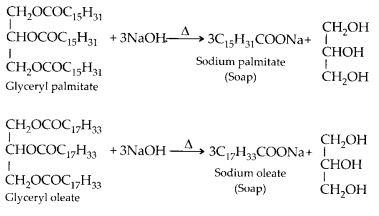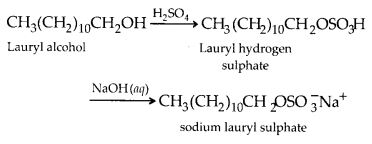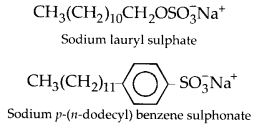NCERT Solutions | Class 12 Chemistry Chapter 16 | Chemistry in Everyday Life

CBSE Solutions | Chemistry Class 12
Check the below NCERT Solutions for Class 12 Chemistry Chapter 16 Chemistry in Everyday Life Pdf free download. NCERT Solutions Class 12 Chemistry were prepared based on the latest exam pattern. We have Provided Chemistry in Everyday Life Class 12 Chemistry NCERT Solutions to help students understand the concept very well.
NCERT | Class 12 Chemistry
| Book: | National Council of Educational Research and Training (NCERT) |
|---|---|
| Board: | Central Board of Secondary Education (CBSE) |
| Class: | 12th |
| Subject: | Chemistry |
| Chapter: | 16 |
| Chapters Name: | Chemistry in Everyday Life |
| Medium: | English |
Chemistry in Everyday Life | Class 12 Chemistry | NCERT Books Solutions
NCERT Exercises
NCERT Solutions for Class 12 Chemistry Chapter 16, Question 1.
Solution.
Most of the dru gs taken in doses higher than recommended may cause harmful effect and act as poison. Therefore, a doctor should always be consulted before taking medicine.NCERT Solutions for Class 12 Chemistry Chapter 16, Question 2.
Solution.
This statement refers to the classification according to pharmacological effect of the drug because any drug which will be used to counteract the effect of excess acid in the stomach will be called antacid.NCERT Solutions for Class 12 Chemistry Chapter 16, Question 3.
Solution.
Those people who have diabetes or who need to control intake of calories, they cannot take sugar. They need its substitute. These substitutes are called artificial sweeteners. These are excreted from the body in urine unchanged.NCERT Solutions for Class 12 Chemistry Chapter 16, Question 4.
- (C15H31COO)3C3H5 – Glyceryl palmitate
- (C17H33COO)3C3H5 – Glyceryl oleate.
Solution.

NCERT Solutions for Class 12 Chemistry Chapter 16, Question 5.

Solution.

The functional groups present in the molecule are alcoholic group and ethereal linkage (—O—).
NCERT Exercises
NCERT Solutions for Class 12 Chemistry Chapter 16, Question 1.
Solution.
In a general way, the drug may be defined as a substance used in the prevention, diagnosis, treatment or cure of diseases. We must classify the drug so as to understand its action on our body. Drugs are classified on the basis of (a) pharmacological effect, (b) drug action, (c) chemical structure and (d) molecular targets.NCERT Solutions for Class 12 Chemistry Chapter 16, Question 2.
Solution.
Drugs usually interact with biomolecules, such as carbohydrates, lipids, proteins and nucleic acids. These are called target molecules or drug targets. These perform various functions in the body. For example, proteins which perform the role of biological catalysts in the body are called enzymes and those which are crucial to communication system in the body are called receptors. Nucleic acids have coded genetic information for the cell. Lipids and carbohydrates are structural parts of the cell membrane.NCERT Solutions for Class 12 Chemistry Chapter 16, Question 3.
Solution.
Macromolecules of biological origin such as carbohydrates, lipids, proteins and nucleic acids.NCERT Solutions for Class 12 Chemistry Chapter 16, Question 4.
Solution.
Drugs are designed to interact with specific targets so that these have the least chance of affecting other targets. Only a doctor can diagnose a disease properly and prescribe the correct medicine in proper dose because excess of medicines may have harmful effects on our body. So we should not take medicines without consulting doctors.NCERT Solutions for Class 12 Chemistry Chapter 16, Question 5.
Solution.
Chemotherapy (literally means chemical treatment) is the science in which chemicals are used for the treatement of diseases. Chemotherapy is defined as the use of chemicals (drugs) to injure or destroy infectious microorganisms without causing any injury to the host. Chemotherapy has developed into a vast subject today and efforts are being continuously made to search new drugs as to free human beings from various types of diseases.NCERT Solutions for Class 12 Chemistry Chapter 16, Question 6.
Solution.
Substrates bind to the active site of the enzyme through a variety of interactions such as ionic bonding, hydrogen bonding, van der Waals interaction or dipol-dipole interaction.NCERT Solutions for Class 12 Chemistry Chapter 16, Question 7.
Solution.
Histamine stimulates the secretion of pepsin and hydrochloric acid in the stomach. The drug cimetidine (antacid) was designed to prevent the interaction of histamine with the receptors present in the stomach wall. This resulted in release of lesser amount of acid. Antacid and antiallergic drugs work on different receptors.NCERT Solutions for Class 12 Chemistry Chapter 16, Question 8.
Solution.
Noradrenaline is one of the Neurotransmitters that plays a role in mood changes. If the level of noradrenalines remains low for some reason, then the signal¬sending activity becomes low and the person suffers from depression. In such situations, antidepressant drugs are required. These drugs inhibit the enzymes which catalyse the degradation of noradrenaline. If the enzyme is inhibited, this important neurotransmitter is slowly metabolised and can activate its receptor for longer periods of time, thus counteracting the effect of depression. Iproniazid and phenylzine are two such drugs.NCERT Solutions for Class 12 Chemistry Chapter 16, Question 9.
Solution.
The range of bacteria or other microorganisms that are affected by a certain antibiotic is expressed as its spectrum of action. Antibiotics which kill or inhibit a wide range of Gram-positive and Gram-negative bacteria are said to be broad spectrum antibiotics, e.g., Chloramphenicol, Tetracycline, etc.NCERT Solutions for Class 12 Chemistry Chapter 16, Question 10.
Solution.
Antiseptics and disinfectants are the chemicals which either kill or prevent the growth of microorganisms. Antiseptics are applied to the living tissues such as wounds, cuts, ulcers and diseased skin surfaces. Examples are furacine, soframicine, etc. These are not ingested like antibiotics. On the other hand, disinfectants are applied to inanimate objects such as floors, drainage system, instruments, etc.Same substances can act as an antiseptic as well as disinfectant by varying the concentration. For example, 0.2% solution of phenol is an antiseptic while its 1% solution is disinfectant.
NCERT Solutions for Class 12 Chemistry Chapter 16, Question 11.
Solution.
Excessive hydrogencarbonate can make the stomach alkaline and trigger the production of even more acid. Metal hydroxides are better alternatives because being insoluble, these do not increase the pH above neutrality. These treatments control only symptoms, and not the cause. Therefore, with these metal salts, the patients cannot be treated easily.The drugs cimetidine (Tegamet) and ranitidine (Zantac) prevent the interaction of histamine with the receptors present in the stomach wall. This resulted in release of lesser amount of acid.
NCERT Solutions for Class 12 Chemistry Chapter 16, Question 12.
Solution.
0.2% solution of phenol is an antiseptic while its 1% solution is disinfectant.NCERT Solutions for Class 12 Chemistry Chapter 16, Question 13.
Solution.
Dettol is a mixture of chloroxylenol (4-chloro-3,5-dimethylphenol) and terpineol.NCERT Solutions for Class 12 Chemistry Chapter 16, Question 14.
Solution.
2-3% solution of iodine in alcohol- water mixture is known as tincture of iodine. It is a powerful antiseptic.NCERT Solutions for Class 12 Chemistry Chapter 16, Question 15.
Solution.
Food preservatives prevent spoilage of food due to microbial growth or these may be defined as the substances which are capable of inhibiting the process of fermentation, acidification or any other decomposition of food. The most commonly used preservatives include table salt, sugar, vegetable oils and sodium benzoate. Salts of sorbic acid and propanoic acid are also used as preservatives.NCERT Solutions for Class 12 Chemistry Chapter 16, Question 16.
Solution.
Use of aspartame is limited to cold foods and soft drinks because it in unstable to heat and decomposes at cooking temperature.NCERT Solutions for Class 12 Chemistry Chapter 16, Question 17.
Solution.
The chemical substances which give sweetening effect to food but do not add any calorie to our body are celled artificial sweetening agents, e.g., aspartame, saccharin etc.NCERT Solutions for Class 12 Chemistry Chapter 16, Question 18.
Solution.
Saccharin is of great value of diabetic persons and people who need to control intake of calories because it is excreted from the body in urine unchanged and appears to be entirely inert and harmless when taken.NCERT Solutions for Class 12 Chemistry Chapter 16, Question 19.
Solution.
Alitame is high potency sweetener (2000 times as sweet as cane sugar). The control of sweetness of food is difficult while using it.NCERT Solutions for Class 12 Chemistry Chapter 16, Question 20.
Solution.
Soaps when used in hard water form insoluble precipitates which separate as scum in water and are useless as cleansing agent. In fact these are hindrance to good washing, because the precipitate adheres onto the fibre of the cloth as gummy mass. On the other hand, synthetic detergents can be used both in soft and hard water as they give foam even in hard water. Some of the detergents give foam even in ice cold water.NCERT Solutions for Class 12 Chemistry Chapter 16, Question 21.
(i) cationic detergents
(ii) anionic detergents and
(iii) non-ionic detergents.
Solution.
(i) Cationic detergents : Cationic detergents are quarternary ammonium salts of amines with acetates, chlorides or bromides as’ anions. Cationic part possess a long hydrocarbon chain and a positive charge on nitrogen atom. Hence, these are called cationicdetergents.Cetyltrimethylammonium bromide is a popular cationic detergent and is used in hair conditioners. Cationic detergents have germicidal properties and are expensive, therefore these are of limited use.
Cationic detergents have germicidal properties and are expensive, therefore these are of limited use.
(ii) Anionic detergents : Anionic detergents are sodium salts of sulphonated long chain alcohols or hydrocarbons. Alkyl hydrogensulphates formed by treating long chain alcohols with concentrated sulphuric acid are neutralised with alkali to form anionic detergents. Similarly alkyl benzene sulphonates are obtained by neutralising alkyl benzene sulphonic acids with alkali.


In anionic detergents, the anionic part of the molecule is involved in the cleansing action. Sodium salts of alkylbenzenesulphonates are an important class of anionic detergents.
They are mostly used for household work. Anionic detergents are also used in toothpastes.
(iii) Non-ionic detergents : Non-ionic detergents do not contain any ion in their constitution. One such detergent is formed when stearic acid reacts with polyethyleneglycol.

Liquid dishwashing detergents are non-ionic type.
NCERT Solutions for Class 12 Chemistry Chapter 16, Question 22.
Solution.
Biodegradable detergents : Detergents having straight hydrocarbon chains are easily degraded by microorganisms and hence are called biodegradable detergents, e.g.,
Non-biodegradable detergents : Detergents containing branched hydrocarbon chains are not easily degraded by the microorganisms and hence are called non-biodegradable detergents.

NCERT Solutions for Class 12 Chemistry Chapter 16, Question 23.
Solution.
Hard water contains calcium and magnesium ions. These ions form insoluble calcium and magnesium soaps respectively when sodium or potassium soaps are dissolved in hard water.
These insoluble soaps separate as scum in water and are useless as cleansing agent. In fact these are hindrance to good washing, because the precipitate adheres onto the fibre of the cloth as gummy mass.
NCERT Solutions for Class 12 Chemistry Chapter 16, Question 24.
Solution.
Soaps and detergents can be used to check the hardness of water. Hard water forms curdy white precipitate with Ca2+ and Mg2+ ions present in hard water whereas no such precipitates are formed by detergents in hard water.NCERT Solutions for Class 12 Chemistry Chapter 16, Question 25.
Solution.
Soap is sodium or potassium salt of a higher fatty acid and may be represented as RCOO– Na (e.g., sodium stearate CH3(CH2)16 COO– Na+ When dissolved in water, it dissociates into RCOO– and Na+ ions. The RCOO– ions, however, consist of two parts – a long hydrocarbon chain R (also called non-polar ‘tail’) which is hydrophobic (water repelling), and a polar group COO- (also called polar-ionic ‘head’), which is hydrophilic (water loving).
The RCOO– ions are, therefore, present on the surface with their COO– groups in water and the hydrocarbon chains R staying away from it and remain at the surface. But at critical micelle concentration, the anions are pulled into the bulk of the solution and aggregate to form a spherical shape with their hydrocarbon chains pointing towards the centre of the sphere with COO– part remaining outward on the surface of the sphere. An aggregate thus formed is known as ‘ionic micelle’. These micelles may contain as many as 100 such ions.
The cleansing action of soap is due to the fact that soap molecules form micelle around the oil droplet in such a way that hydrophobic part of the stearate ions is in the oil droplet and hydrophilic part projects out of the grease droplet like the bristles. Since the polar groups can interact with water, the oil droplet surrounded by stearate ions is now pulled in water and removed from the dirty surface. Thus soap helps in emulsification and washing away of oils and fats. The negatively charged sheath around the globules prevents them from coming together and forming aggregates.

NCERT Solutions for Class 12 Chemistry Chapter 16, Question 26.
Solution.
Synthetic detergents.NCERT Solutions for Class 12 Chemistry Chapter 16, Question 27.
- CH3(CH2)10CH2OSO–3Na+
- CH3(CH2)15 N+ (CH3)3 Br
- CH3(CH2)16COO(CH2CH2O)nCH2CH2OH
Solution.

NCERT Class 12 Chemistry
Class 12 Chemistry Chapters | Chemistry Class 12 Chapter 16
Chapterwise NCERT Solutions for Class 12 Chemistry
-
NCERT Solutions For Class 12 Chemistry Chapter 1 The Solid State
NCERT Solutions For Class 12 Chemistry Chapter 2 Solutions
NCERT Solutions For Class 12 Chemistry Chapter 3 Electro chemistry
NCERT Solutions For Class 12 Chemistry Chapter 4 Chemical Kinetics
NCERT Solutions For Class 12 Chemistry Chapter 5 Surface Chemistry
NCERT Solutions For Class 12 Chemistry Chapter 6 General Principles and Processes of Isolation of Elements
NCERT Solutions For Class 12 Chemistry Chapter 7 The p Block Elements
NCERT Solutions For Class 12 Chemistry Chapter 8 The d and f Block Elements
NCERT Solutions For Class 12 Chemistry Chapter 9 Coordination Compounds
NCERT Solutions For Class 12 Chemistry Chapter 10 Haloalkanes and Haloarenes
NCERT Solutions For Class 12 Chemistry Chapter 11 Alcohols Phenols and Ethers
NCERT Solutions For Class 12 Chemistry Chapter 12 Aldehydes Ketones and Carboxylic Acids
NCERT Solutions For Class 12 Chemistry Chapter 13 Amines
NCERT Solutions For Class 12 Chemistry Chapter 14 Biomolecules
NCERT Solutions For Class 12 Chemistry Chapter 15 Polymers
NCERT Solutions For Class 12 Chemistry Chapter 16 Chemistry in Everyday Life
| NCERT Solutions for Class 12 All Subjects | NCERT Solutions for Class 10 All Subjects |
| NCERT Solutions for Class 11 All Subjects | NCERT Solutions for Class 9 All Subjects |

Post a Comment
इस पेज / वेबसाइट की त्रुटियों / गलतियों को यहाँ दर्ज कीजिये
(Errors/mistakes on this page/website enter here)